Weaving a four-plait cord
9 July 2008Click here to visit an upgraded version of this blog post on my new website at alibrown.nz.
 According to archaeologists, cords have been made by plaiting or twisting plant materials since about 17,000 BC, typically nettles, hemp, cotton, sisal and jute. In traditional Māori culture, cord has been made from New Zealand flax, which is probably at least as strong and durable as any other plant material. Before rope began to be made from plastics in the late twentieth century, its manufacture from flax fibre was one of New Zealand’s major export industries.
According to archaeologists, cords have been made by plaiting or twisting plant materials since about 17,000 BC, typically nettles, hemp, cotton, sisal and jute. In traditional Māori culture, cord has been made from New Zealand flax, which is probably at least as strong and durable as any other plant material. Before rope began to be made from plastics in the late twentieth century, its manufacture from flax fibre was one of New Zealand’s major export industries.
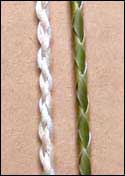 Flax can be plaited from its fibre or from strips, and the photo to the right shows a four-plait made from flax fibre, or muka, on the left side of the photo and one from strips on the right side. A plait made from fibre is a good deal stronger than one made from strips, but plaited strips are much quicker to make and look quite attractive, particularly the four-plait, which can be woven in a tubular shape. A disadvantage of the tubular shape is that it can become crushed if used as a handle for a basket carrying heavy weights, but it’s quite suitable for a small basket and it’s particularly suitable for a pendant.
Flax can be plaited from its fibre or from strips, and the photo to the right shows a four-plait made from flax fibre, or muka, on the left side of the photo and one from strips on the right side. A plait made from fibre is a good deal stronger than one made from strips, but plaited strips are much quicker to make and look quite attractive, particularly the four-plait, which can be woven in a tubular shape. A disadvantage of the tubular shape is that it can become crushed if used as a handle for a basket carrying heavy weights, but it’s quite suitable for a small basket and it’s particularly suitable for a pendant.
A number of the participants in my workshops have asked me how to weave a tubular four-plait, and I know of only one flax weaving book — Fun with Flax — that includes instructions. Unfortunately, people have not always found written instructions easy to follow, so I’m not sure whether the instructions below will be easy to follow either. If you don’t find them easy, you won’t be alone. It sometimes takes a while to get the hang of four-plaiting even when it’s taught in person.
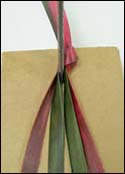 A four-plait cord made from strips becomes tubular because the shiny side of each strip is kept to the outside of the cord all the time as you plait. Start with four flax strips all the same width. As for any cord, it’s easier to get an even plait if you have one end of the work held by a friend or you tie the end around a solid object such as a chair leg or a nail in a piece of wood. This means you can pull the strands towards you as you plait, so you can keep an even tension on the plaiting. Here I’ve used a nail banged into a piece of wood. Arrange the strips so that the shiny side of each strip is showing uppermost.
A four-plait cord made from strips becomes tubular because the shiny side of each strip is kept to the outside of the cord all the time as you plait. Start with four flax strips all the same width. As for any cord, it’s easier to get an even plait if you have one end of the work held by a friend or you tie the end around a solid object such as a chair leg or a nail in a piece of wood. This means you can pull the strands towards you as you plait, so you can keep an even tension on the plaiting. Here I’ve used a nail banged into a piece of wood. Arrange the strips so that the shiny side of each strip is showing uppermost.
I’ve used two strips of dyed green flax and two strips of dyed red flax for these illustrations to show the plaiting sequence more easily. If you are using two different colours, arrange the colours so that one colour is used for the two outside strips and the second colour is used for the two inside strips.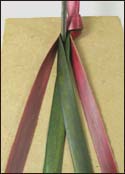
To start plaiting, grasp the middle two green strips, and cross the left-hand one over the right-hand one, keeping the shiny side uppermost.
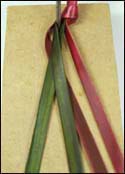
Then take the outside left-hand red strip, and bring it under the two green strips to the right of it, turning it so the shiny side of the flax will be showing on the underneath of the cord. This means that the dull side of the strip is showing at the front.
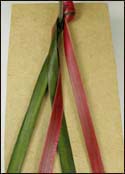
Bring this strip around and over one green strip next to it on the left. The shiny side of this strip should now be showing.
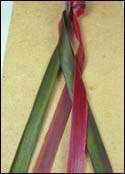
Go to the right hand side of the plait and take the outside red strip to the left under the next two strips, (one is red and one is green), keeping the shiny side of the flax on the outside of the cord so that the dull side shows on the front.
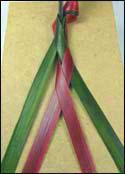
Bring this strip around and over the one red strip to the right of it so that the shiny side of this strip is now showing. Note that the two green strips are now on the outside and the two red strips are in the middle.
These four steps, from the fifth illustration from the top of this post to this eighth illustration, are now repeated. Note that the first movement of crossing the centre two strips, shown in the fourth illustration from the top of the post, is a starting movement only, and is not included in the continuing sequence.
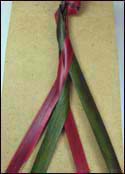
To continue, go back to the left hand side and take the outside green strip under the two red strips and then turn it back over one red strip, making sure you keep the shiny side of the flax on the outside of the cord as you do this.
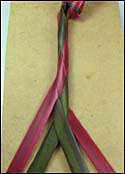
Now go the right hand side and take the outside green strip under two strips, (one is green and one is red), and then turn it back over one green strip. Pull the strips out each side and up so that the plaiting tightens up and the tubular shape and pattern of the cord starts showing. Continue plaiting, pulling the plait up tightly and evenly as you go.
 The nice thing about weaving a four-plait cord with two different colours is that the colours spiral around the cord, giving it a candy-stripe effect, which I find very attractive.
The nice thing about weaving a four-plait cord with two different colours is that the colours spiral around the cord, giving it a candy-stripe effect, which I find very attractive.
The plait made with flax fibre, or muka, shown on the left in the photo toward the top of this post, is plaited in the same way as the one made with strips but because each set of fibre strands that is being plaited is round rather than flat like a strip, it does have a different look to it.
Modification 25 Jan 2010
I have replaced the original illustrations for this post, where I used four flax strips of the same colour, with illustrations using flax strips of two different colours. This is a result of a participant in one of my recent workshops finding it much easier to remember the plaiting sequence when we used two different colours for the plaiting strips.
© Alison Marion Brown 2008.


July 14th, 2008 at 8:05 pm
Thank you Ali! I really enjoyed your workshop in Lyttelton and your website indeed. I’m sure I’ll see you again and will pass this on to my friends. Thanks again.
July 15th, 2008 at 6:39 pm
Hi Ann Charlotte
I’m glad you enjoyed the workshop and thanks for your kind comments. Hope to see you again!
January 19th, 2009 at 3:56 pm
Hi Ali
Is there any chance of showing how to make a simple kete for viewers
January 19th, 2009 at 5:00 pm
Hi Jan
I’m not planning to do instructions for a simple kete on the blog but you can find instructions for it in the second book I mention on my Reviews page. The book is Maori Weaving by Erenora Puketapu-Hetet and it should be available in your local library.
March 30th, 2009 at 11:59 pm
Thanks Ali.Great to find your site.
June 9th, 2009 at 1:57 pm
Hi Ali
Thank you so much for this site….I’d forgotten how to do the four plait and its refreshing to know its here.
Kia ora and it is great to find your site.
June 29th, 2009 at 10:44 am
try it in poi
June 29th, 2009 at 9:32 pm
Hi Ali,
Came across your page when searching for clues on how to plait a 4 conductor handset cord for an antique telephone. It works too- thanks:-)
August 8th, 2009 at 9:22 pm
Thanks so much for this site, I have been pain stakingly making a korowai for my daughter and needed a tie to hold it together and thought a four plait cord would do the trick nicely. Jumped online and here you were……awesome…..saved to my favourites
August 24th, 2009 at 8:47 pm
hi the flax weaving is so good and help-ful
November 4th, 2009 at 6:50 pm
Hi I just learnt how to make a basket but have been struggling to make a rectangular one! I did the multiples of 4 ie: one side 12 and folded the 7th ( on both the longer edge - the opposites) then the other 8 and folded the 5th. But it didnt work.
Hope you know what I mean!
November 5th, 2009 at 5:21 pm
Hi Pauline
I’m sorry but it’s a little difficult to know where you are at with the corners from your description and I don’t want to give you other directions that may be more confusing for you.
Are you able to look at Mick Pendergrast’s book Te Mahi Kete: Maori Flaxcraft for Beginners, as that has instructions on how to do a basket with four corners which may help you.
November 8th, 2009 at 4:16 pm
Dear Ali,
How much fun is this? Thanks so much, the instructions are great. I live in Sydney and I’m practising with an Australian native - a Dianella species and will try Lomandra longifolia next. There is a lot of New Zealand flax that grows here but not in my backyard. If you know of any resources in Sydney let me know.
Cheers,
Tanja
November 9th, 2009 at 2:21 pm
Hi Tanja
Glad you enjoyed making the cord and it’s good to hear that the technique is working with different materials other than flax. I’m currently gathering information on different plant materials to use for making flowers so your comment is very useful, thanks.
October 8th, 2010 at 1:00 am
this is great. my mums cousin is a master weaver and she got me into this i am now using flax for my GCSE graphics project.
her name is Mandy Sunlight.
October 10th, 2010 at 8:24 pm
Thanks for letting me know about your graphics project. I hope it goes well! I’d love to see what you are doing if you have any photos to send me. Your mum’s cousin Mandy Sunlight does beautiful weaving and you can see images of some of her weaving is on my Links page.
March 2nd, 2011 at 10:10 am
Hi Ali, just wondering what knot or method that you would use to end the rope? Thanks.
March 2nd, 2011 at 6:36 pm
Hi Flaxman
When I use the rope for a handle, I generally split the rope into two lots of two strips, push each set of two strips through different parts of the weaving of the bag at the right placement for a handle, and then plait the strips together with a 3 plait (using 2 strips as one for one of the 3-plait strips), to secure the handle in place. Otherwise I shred the ends once thay are inside the bag and then plait them. This makes for a strong handle.
But maybe you just want to know how to end the plait itself in an attractive way! I knot all the ends together in one knot and position the knot so it sits nicely against the plait, and then cut the ends off closely, or leave them out for a decorative end.
I knot all the ends together in one knot and position the knot so it sits nicely against the plait, and then cut the ends off closely, or leave them out for a decorative end.
Alternatively, I suggest you try a Crown Sinnet knot which makes for a more decorative effect.
April 19th, 2011 at 7:38 pm
HELLO
I AM MAKING REPAIRS TO AN OLD MAORI ADZE AND NEED TO LOCATE SOME FLAX CORD FOR BOTH THE WRIST STRAP, AND THE BINDING TO HOLD THE STONE TO THE HANDLE
IS THERE ANYONE WHO SELLS LENGTHS OF TRADITIONAL FLAX CORDS IN NZ PLEASE
CHEERS PETER
April 23rd, 2011 at 2:51 pm
Hi Peter
I don’t know of anyone but hopefully someone will see your comment and leave a reply.
May 31st, 2011 at 6:52 am
Just discovered this site. Thank you for your ever so generously informative responses. A fellow lauhala weaver just returned from Auckland and brought me a flax flower and a small supply of strips. Gorgeous! I think your book will be a present to myself very soon. Angels are a favorite project. I have a woven design that is hankering to be attempted in flax.
Mahalo, Fumi
June 4th, 2011 at 10:24 am
Hello Fumi
Thanks for your comments. I’d be interested to see your woven design once you’ve made it in flax. Do send me a photo when it’s finished.
May 14th, 2015 at 4:51 pm
Hi. I am binding a greenstone to make a necklace for my son. Can you please tell me how to make a simple toggle clasp out of plaited waxed cord.
Many thanks
July 4th, 2018 at 4:51 pm
Hi Ali, I want to extend my cord to make it longer but I can’t remember how to add extra strands without the whole thing falling apart. I need to weave about 8mtrs. Can you help?
Thanks
Allison
July 4th, 2018 at 5:18 pm
Hi Allison, if you are weaving this four-plait cord, then add new strips in one at a time, so they are not all being added at the same time. Add the strip by weaving it together with the old strip for several turns. Start adding the first one before you need to and then add the others at intervals after that.
December 17th, 2019 at 6:30 pm
Love your work. Do you have a demo video of it as well as of Kupenga Kete? Thanks
December 21st, 2019 at 12:16 pm
Thanks Nelly. No sorry I don’t have time to do demo videos. This blog post has information and illustrations on making the Kupenga kete.